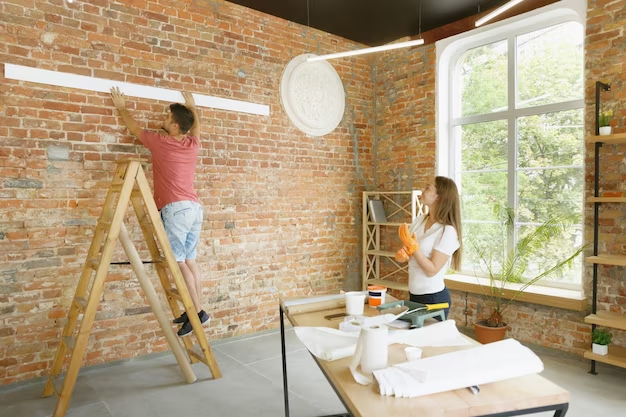Embarking on a home renovation journey often begins with the thought, “I want to renovate my house, where do I start?” It’s a pivotal question that leads to setting the stage for a successful transformation. Before diving into color palettes and fixtures, you must lay down a solid foundation of planning and strategic thinking. Understanding where to start renovating a house is essential for enhancing aesthetics, increasing functionality, and ensuring the value of your property skyrockets.
Planning Your Home Renovation
Assessing Your Home’s Needs
In contemplating “where to start renovating a house,” the sensible first step is to assess the current state of your home. To build upon this initial thought, follow a dual evaluation approach involving both expert input and personal insights:
- Professional Inspection: A professional assessment can pinpoint underlying issues, from structural weaknesses to outdated systems that need rectification – often the answer to the common homeowner’s query: “When renovating, what to do first?”
- Personal Assessment: Taking a personal inventory of what changes would enhance your living experience is also crucial. Reflect on what prompted the thought, “how to start renovating houses,” and let your daily life guide you in creating a wish list for your home’s transformation.
| Key Home Assessments | Professional Inspector’s Focus | Homeowner’s Focus |
|---|---|---|
| Structural Integrity | Foundation cracks, roof condition, load-bearing walls | Space rearrangements, extensions |
| Systems Evaluation | Plumbing, electrical, HVAC systems | Upgrade of fixtures, energy efficiency |
| Safety Check | Building code compliance, potential hazards | Child-proofing, accessibility features |
| Aesthetic Appeal | Potential for cosmetic enhancements | Style and décor preferences |

Budgeting for Renovation
When considering the journey of renovation, often the question arises, “Home renovation, where to start?” The answer frequently points towards establishing a realistic and manageable budget.
- Establish a Financial Plan: Determine a budget that reflects the scope of your renovation while maintaining a safety net for unexpected costs. Remember the importance of flexibility in your financial plan, as renovation often presents unforeseen challenges along the way.
- Consider Cost-Saving Options: In your quest to cut unnecessary expenses, you’ll find numerous ways to be economical without sacrificing the end result of your house makeover. This financial prudence is especially relevant to those wondering “how to start renovating houses” while keeping a close eye on their investment.
Designing the Renovation
The conception of your home’s new look and feel is where your vision turns into a tangible plan – a vision that likely began with a simple thought: “I want to renovate my house, where do I start?”
- Choosing a Design Style: As you ponder the design path that suits your taste and lifestyle, it will become evident why establishing a clear aesthetic vision early on is so critical to the entire project.
- Functional vs. Aesthetic Improvements: A beautiful home must also serve your needs effectively, making it important to balance the allure of new aesthetics with the practicalities of day-to-day life.
The Renovation Process
Obtaining Permits and Approvals
The adage “when renovating what to do first” often comes down to the less glamorous yet utterly crucial task of navigating the bureaucratic waters of permits and legal approvals.
- Understanding Local Regulations: A foray into local building codes and permitting procedures is a critical preparatory step to ensure that your renovation plans comply with all regulations.
- Securing Necessary Permissions: Setting this legal groundwork not only aligns with due diligence but secures your investment and safeguards against future complications.
Choosing the Right Contractors
Finding professionals who resonate with your vision can make all the difference in bringing your renovation dream to life—your choices here are as consequential as the initial decision on where to begin.
- Vetting and Selecting Professionals: Explore and shortlist skilled practitioners who not only command respect in their fields but also demonstrate an understanding of your project’s unique needs and your starting point query, “home renovation where to start.”
- Communicating Your Vision: Convey your goals, style choices, and practical requirements to your team clearly. This open dialogue is essential in aligning their efforts with your expectations for the house renovation.
As we conclude this part of our home renovation guide, we’ve tackled the critical starting points and planning phases required to set your renovation on a sure path to success. The following sections will delve into the practical steps of putting your plans into action, living through the renovation, and adding those final touches that turn a house into your home.
Executing the Renovation
Prioritizing Projects
The second phase of renovating your home requires prioritizing projects—determining the order in which tasks should be tackled. This pivotal point is where efficient project management intersects with strategic planning.
- Structural vs. Cosmetic Changes: Often, addressing structural issues is paramount because they ensure the safety and longevity of your home. Begin with the framework and infrastructure, ensuring a solid base upon which cosmetic alterations can be made.
- Phased Renovation Approach: Depending on your budget and timelines, consider renovating in phases. This approach allows you to spread out the cost and disruption, making it manageable to live in your home during the renovation process if you choose.
Living through Renovation
As renovations commence, homeowners must adapt to the transformation of their living spaces. Here, resilience and patience play vital roles in navigating this typically chaotic period.
- The construction phase can offer unique challenges, including noise, dust, and the general upheaval of your daily routine. Preparing a temporary living space, either within the home or externally, can alleviate the stress that comes with the territory.
- Unexpected delays or overruns are part of any substantial project. Maintain open communication with your contractors, and be prepared for adjustments to timelines and possibly even temporary relocations to ensure a smooth renovation process.

The Finishing Touches
Interior Decoration and Styling
Adding your personal touch becomes the final stroke of the brush in the renovation artwork. Selecting the interior elements that reflect your style defines the essence of the living space.
- Choosing the right color palettes, textiles, and finishes brings continuity throughout your home, creating the desired atmosphere and comfort that personalizes your environment.
- The functionality of your space can be elevated through the strategic placement of lighting, furniture, and technological integrations, ensuring that the renovation serves your lifestyle.
Landscaping and Exterior Work
The exterior of your home deserves just as much attention as the interior. After all, first impressions are often made from the curb.
- Beyond aesthetic appeal, thoughtfully designed outdoor spaces contribute to your home’s overall functionality and enjoyment—whether you’re looking to entertain, cultivate a garden, or create play areas for children.
- Considerations for sustainability, such as drought-resistant plants or efficient irrigation systems, guarantee not only a beautiful landscape but an environmentally conscious one.
Conclusion
Renovating a house is a formidable but immensely rewarding venture. It starts with establishing a clear, achievable vision and continues through meticulous planning, adept execution, and final decorative touches. The result should be a reflection of your needs, aesthetic preferences, and the love you have for your home, providing you with a rejuvenated space that enhances both your lifestyle and property value.

FAQs Following the Conclusion
Q1: What is the most important thing to consider before starting a house renovation?
A1: Before starting a house renovation, it is crucial to assess your home’s structural needs, set a realistic budget that includes a contingency for unexpected costs, and craft a clear vision for your desired outcome. Ensuring you have the proper permits and a solid plan in place is essential for a smooth renovation process.
Q2: How long should I expect to live in a construction zone when renovating my house?
A2: The duration of living in a construction environment can vary widely depending on the scope of the renovation. Minor remodels may only take a few weeks, while extensive renovations could last several months. Always account for potential delays when planning the project timeline.
Q3: Should I stay in my home during the renovation, or is it better to move out temporarily?
A3: This decision should be based on the extent of the renovation, your capacity to handle disruption, and your budget. For minor changes, staying may be more practical. However, if the renovation is extensive and impacts essential areas like the kitchen and bathroom, temporary relocation might be more comfortable.
Q4: Can I do any part of the renovation work myself to save on costs?
A4: DIY can reduce costs, but it’s important to gauge your skill level honestly before taking on tasks. For complex renovations like electrical work or structural changes, it’s advisable to hire professionals to ensure safety and quality.
Q5: How do I ensure that the renovation will add value to my house?
A5: To ensure that your renovation adds value to your home, focus on key improvements that have a high return on investment, such as updating kitchens and bathrooms, enhancing curb appeal, or adding space. Consult with a real estate expert and hire reputable designers and contractors to maximize the impact of your renovation.


